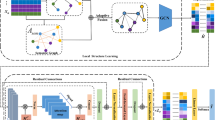Abstract
In this paper, we look at the problem of completing an open-world knowledge graph by describing entities. Many open-world knowledge graph completion (KGC) models train alignment functions that map embeddings based on textual descriptions to structural embedding spaces. They then use traditional closed-world KGC models to predict missing facts. When generating and aligning textual embeddings for the open world knowledge graph completion task, most existing approaches ignore the effect of relations. This means that noise from the texts gets into feature extraction, which hurts model performance. So, a new open-world KGC model called EmReCo is proposed. It is based on relation-specific constraints and focuses on relation-correlated information extraction from entity descriptions with a relation-aware attention aggregator for better textual embeddings. A relation-specific gate filtering mechanism is also made to keep relation-specific features in the entity embeddings. Extensive tests on two benchmark open-world datasets show that EmReCo gets great results, especially with long text datasets, and that the best metric, Hits@1, can get better by 8.1%.





Similar content being viewed by others
References
Suchanek FM, Kasneci G, Weikum G (2007) Yago: a core of semantic knowledge. In: Proceedings of the 16th international conference on World Wide Web, pp 697–706. https://doi.org/10.1145/1242572.1242667
Bollacker K, Evans C, Paritosh P et al (2008) Freebase: a collaboratively created graph database for structuring human knowledge. In: Proceedings of the 2008 ACM SIGMOD international conference on Management of data, pp 1247–1250. https://doi.org/10.1145/1376616.1376746
Lehmann J, Isele R, Jakob M et al (2015) Dbpedia–a large-scale, multilingual knowledge base extracted from wikipedia. Semant Web 6(2):167–195. https://doi.org/10.3233/SW-140134
Zhang F, Yuan NJ, Lian D et al (2016) Collaborative knowledge base embedding for recommender systems. In: Proceedings of the 22nd ACM SIGKDD international conference on knowledge discovery and data mining, pp 353–362. https://doi.org/10.1145/2939672.2939673
Berant J, Chou A, Frostig R et al (2013) Semantic parsing on freebase from question-answer pairs. In: Proceedings of the 2013 conference on empirical methods in natural language processing, pp 1533–1544
Hoffmann R, Zhang C, Ling X et al (2011) Knowledge-based weak supervision for information extraction of overlapping relations. In: Proceedings of the 49th annual meeting of the association for computational linguistics: human language technologies, pp 541–550
Daiber J, Jakob M, Hokamp C et al (2013) Improving efficiency and accuracy in multilingual entity extraction. In: Proceedings of the 9th international conference on semantic systems, pp 121–124. https://doi.org/10.1145/2506182.2506198
Bordes A, Chopra S, Weston J (2014) Question answering with subgraph embeddings. arXiv:14063676
Bordes A, Usunier N, Garcia-Duran A, et al (2013) Translating embeddings for modeling multi-relational data. Adv Neural Inf Process Syst 26:2787–2795
Yang B, Yih Wt, He X et al (2014) Embedding entities and relations for learning and inference in knowledge bases. arXiv:14126575
Trouillon T, Welbl J, Riedel S et al (2016) Complex embeddings for simple link prediction. In: International conference on machine learning, PMLR, pp 2071–2080
Lin Y, Liu Z, Sun M, et al (2015) Learning entity and relation embeddings for knowledge graph completion. In: Proceedings of the Twenty-Ninth AAAI Conference on Artificial Intelligence. AAAI Press, AAAI’15, p 2181–2187
Zhang F, Wang X, Li Z et al (2021) Transrhs: a representation learning method for knowledge graphs with relation hierarchical structure. In: Proceedings of the twenty-ninth international conference on international joint conferences on artificial intelligence, pp 2987–2993
Chao L, He J, Wang T et al (2020) Pairre: knowledge graph embeddings via paired relation vectors. arXiv:201103798
Nguyen DQ, Vu T, Nguyen TD et al (2020) Quatre: relation-aware quaternions for knowledge graph embeddings. arXiv:200912517
Shi B, Weninger T (2018) Open-world knowledge graph completion. In: Thirty-Second AAAI conference on artificial intelligence
Shah H, Villmow J, Ulges A et al (2019) An open-world extension to knowledge graph completion models. In: Proceedings of the AAAI conference on artificial intelligence, pp 3044–3051. https://doi.org/10.1609/aaai.v33i01.33013044
Zhou Y, Shi S, Huang H (2020) Weighted aggregator for the open-world knowledge graph completion. In: International conference of pioneering computer scientists, engineers and educators, Springer, pp 283–291. https://doi.org/10.1007/978-981-15-7981-3_19
Shah H, Villmow J, Ulges A (2020) Relation specific transformations for open world knowledge graph completion. In: Proceedings of the graph-based methods for natural language processing (TextGraphs), pp 79–84. https://doi.org/10.18653/v1/2020.textgraphs-1.9
Nickel M, Tresp V, Kriegel HP (2011) A three-way model for collective learning on multi-relational data. In: Icml
Zhang S, Tay Y, Yao L et al (2019) Quaternion knowledge graph embeddings. Adv Neural Inf Process Syst 32:2735–2745
Goldberg Y (2016) A primer on neural network models for natural language processing. J Artif Intell Res 57:345–420. https://doi.org/10.1613/jair.4992
Bahdanau D, Cho K, Bengio Y (2014) Neural machine translation by jointly learning to align and translate. arXiv:14090473
Hochreiter S, Schmidhuber J (1997) Long short-term memory. Neural Comput 9(8):1735–1780. https://doi.org/10.1162/neco.1997.9.8.1735
Cho K, Van Merriënboer B, Gulcehre C et al (2014) Learning phrase representations using rnn encoder-decoder for statistical machine translation. arXiv:14061078
Han X, Cao S, Lv X et al (2018) Openke: an open toolkit for knowledge embedding. In: Proceedings of the 2018 conference on empirical methods in natural language processing: system demonstrations, pp 139–144
Schuster M, Paliwal KK (1997) Bidirectional recurrent neural networks. IEEE Trans Signal Process 45(11):2673–2681. https://doi.org/10.1109/78.650093
Acknowledgements
This work was supported by the Natural Science Foundation of Fujian, China(No. 2021J01619), the National Natural Science Foundation of China(No.61672159).
Author information
Authors and Affiliations
Corresponding author
Ethics declarations
Competing interests
The authors declare that they have no known competing financial interests or personal relationships that could have appeared to influence the work reported in this paper.
Additional information
Publisher’s note
Springer Nature remains neutral with regard to jurisdictional claims in published maps and institutional affiliations.
Rights and permissions
Springer Nature or its licensor holds exclusive rights to this article under a publishing agreement with the author(s) or other rightsholder(s); author self-archiving of the accepted manuscript version of this article is solely governed by the terms of such publishing agreement and applicable law.
About this article
Cite this article
Wang, J., Lei, J., Sun, S. et al. Embeddings based on relation-specific constraints for open world knowledge graph completion. Appl Intell 53, 16192–16204 (2023). https://doi.org/10.1007/s10489-022-04247-z
Accepted:
Published:
Issue Date:
DOI: https://doi.org/10.1007/s10489-022-04247-z




